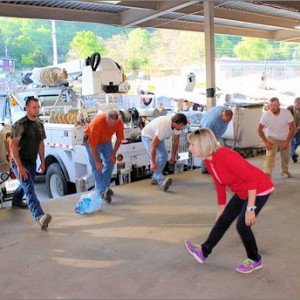
A Beginner’s Guide to Fascia Training

Note: This is a guest post by Daniel Smith from blackroll.com.au.
When you think of stretching, you probably think of stretching the muscles and joints in your back, arms and legs. Indeed, this is an effective means of improving your flexibility and range of motion, which can improve your performance in a range physical activities. However, what you probably don’t think of is stretching your fascia. This is because fascia is a poorly understood, and often undervalued tissue that until recently has been absent from research on exercise and well-being.
In 2007, the world’s first research conference was held to discuss and raise awareness about the important role the fascia system plays within the body, and how through fascia training, connective tissue can be strengthened. Fascia training has since gained the attention of health professionals as the benefits and importance of such training have become better known.
Everyone – including top athletes, sporting professionals and the everyday fitness gurus – have not only become aware of the importance of fascia training, but include it as part of their daily exercise regime.
This guide on fascia training will introduce you to the fascia system and highlight how fascia training can significantly enhance your mobility, recovery, and general well-being.
What is Fascia?
To understand the importance of fascia training, you first need to be aware of the fascia system and its vital role in providing muscle memory and helping you move.

Fascia is the term used to describe the band or sheet of tissue that connects muscles and other organs within the body. Important body structures including tendons, ligaments, nerves, muscles and bones, which work to move our body, are all part of the fascia system. The fascia system is, therefore, everywhere within your body, holding everything in place and giving your body structure. As it unites the whole body, proper movement and total well-being are reliant on a healthy and robust fascia system.
There are three basic functions of the fascia:
- Shape: Fascia holds muscles together and keeps everything in shape.
- Move: Fascia, along with other body structures, contributes to posture and movement. When functioning optimally, fascia will lead to coordinated and unrestricted movement and will prevent injury.
- Support: As fascia is connected to all structures, it is responsible for supporting and protecting muscles and other vital body organs.
Fascia tissue predominantly consists of free-moving and bound water molecules, with H2O being fundamental to fascia health and elasticity. When you exercise and stretch, the water is squeezed out of the stressed areas. Without proper re-hydration, the fascia becomes dry, preventing movement and increasing the chance of injury. A great example is a sponge. When it is wet, you can easily bend and move it in any direction. When it dries, however, the sponge becomes stiff, brittle, and less mobile. Your fascia system works in much the same way.
Fascia can also develop problems as a result of improper movement or movement that focuses too little or too much on one area of the body. Poor posture is a typical example of abnormal fascia movement. Tension develops in the slumped areas as the fascia is forced to support the muscles carrying the extra weight. Over time, this leads to fascia damage and eventual pain.
An Introduction to Fascia Training
Now that you know about the vital role fascia plays in your body, it’s time to learn about fascia training and why you should include fascia training as part of your regular exercise.
Drinking enough water, unfortunately, isn’t enough to ensure the fascia remains hydrated throughout the body. This is because water does not always get into all areas within the fascia, which is why we need to exercise and move our bodies. Fascia training incorporates movements and exercises that aim to strengthen and improve the elasticity of the connective tissues. Correct movement will ensure that our whole body remains hydrated, preventing the fascia from drying out.
Fascia training often involves movements and exercises that ‘roll out’ our body. Rolling refers to applying pressure on the different layers of muscle and connective tissue, which straightens and smooths out the fascia. The stretching and rolling of the fascia also removes adhesions and improves mobility and flexibility. Therefore, an essential part of fascia training is ensuring we roll out all parts of our bodies, as opposed to just focusing on specific areas.
Training is also crucial to enhancing your performance both on the sports field and in your day-to-day life. Performance is not only a reflection of muscle power but also the strength and mobility of your fascia.

Training is beneficial to all people no matter their age. As we age, our fascia increasingly dries out, which can lead to limited mobility and increased likelihood of injury.
Some of the Benefits of Fascia Training:
- Improves the effectiveness of rehabilitation programs and exercises.
- Enhances the elasticity and performance capacity of the muscular system.
- Prevents sports injuries.
- Relieves pain the back, shoulders, necks and legs.
- Reduces injury and tear.
- Improves balance and coordination.
- Increases circulation and blood flow.
- Improves day-to-day performance and well-being.
Fascia Training Exercises
There are four different types of fascia training exercises:
- Stretching: When stretching the entire body, the flexibility of the fascia will improve.
- Rebound elasticity: Movements like jumps, high knees and skipping improve elastic rebound and strengthen the fascia.
- Proprioceptive refinement: Kinaesthetic exercises help you to develop an awareness of your body and how it moves. This improves strength and balance as your body will become more controlled and have improved technique.
- Facial release: The use of foam rollers and massage products designed for fascia training to self-massage and help rehydrate and strengthen fascia. Pressure is applied using your body weight which increases blood flow and stimulates the tissue.
Rest is also crucial in ensuring you get the most from fascia training. When resting, you’re allowing the fascia to absorb water. Continuing to exercise without ample rest, on the other hand, prevents sufficient water from being reabsorbed.
The Blackroll Fascia App covers a wide range of fascia training exercises. Fascia training can be separate from your regular exercise or incorporated into your daily workout. It is recommended that you do fascia-focused training 2-3 times per week and that you set aside significant time (at least 15 – 20 minutes) to work on each part of the body, including the calves, hamstrings, quadriceps, core and trunk, and arms and upper back.
Conclusion
Fascia is a collective tissue that connects all your muscles and organs providing support and enabling movement. Without proper hydration and regular movement, the fascia can become dry which reduces performance and can lead to adhesions within the fascia. Fascia training strengthens and rehydrates the fascia, keeping the fascia healthy and at its best. A healthy fascia is fundamental to preventing pain and injury, enhancing performance and improving mobility and flexibility.
If you found this article useful, why not share with your friends and family on social media?
As always, best of luck with your home workouts. Remember: When it comes to our health and fitness, we can make the effort or make excuses, but we can’t make both.






